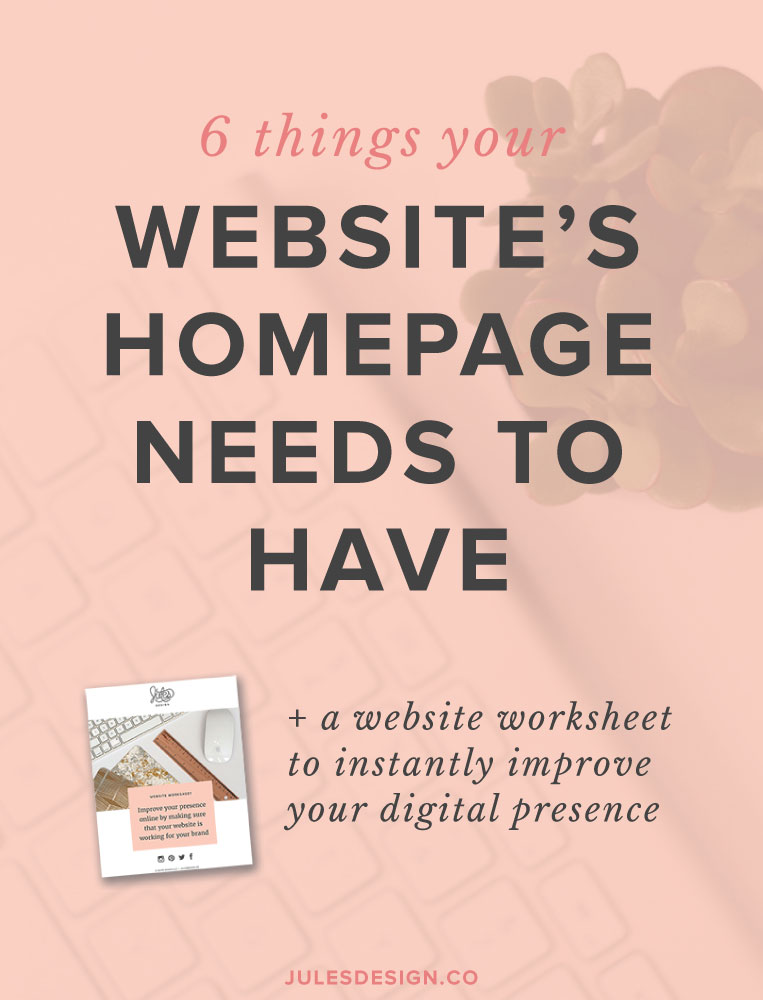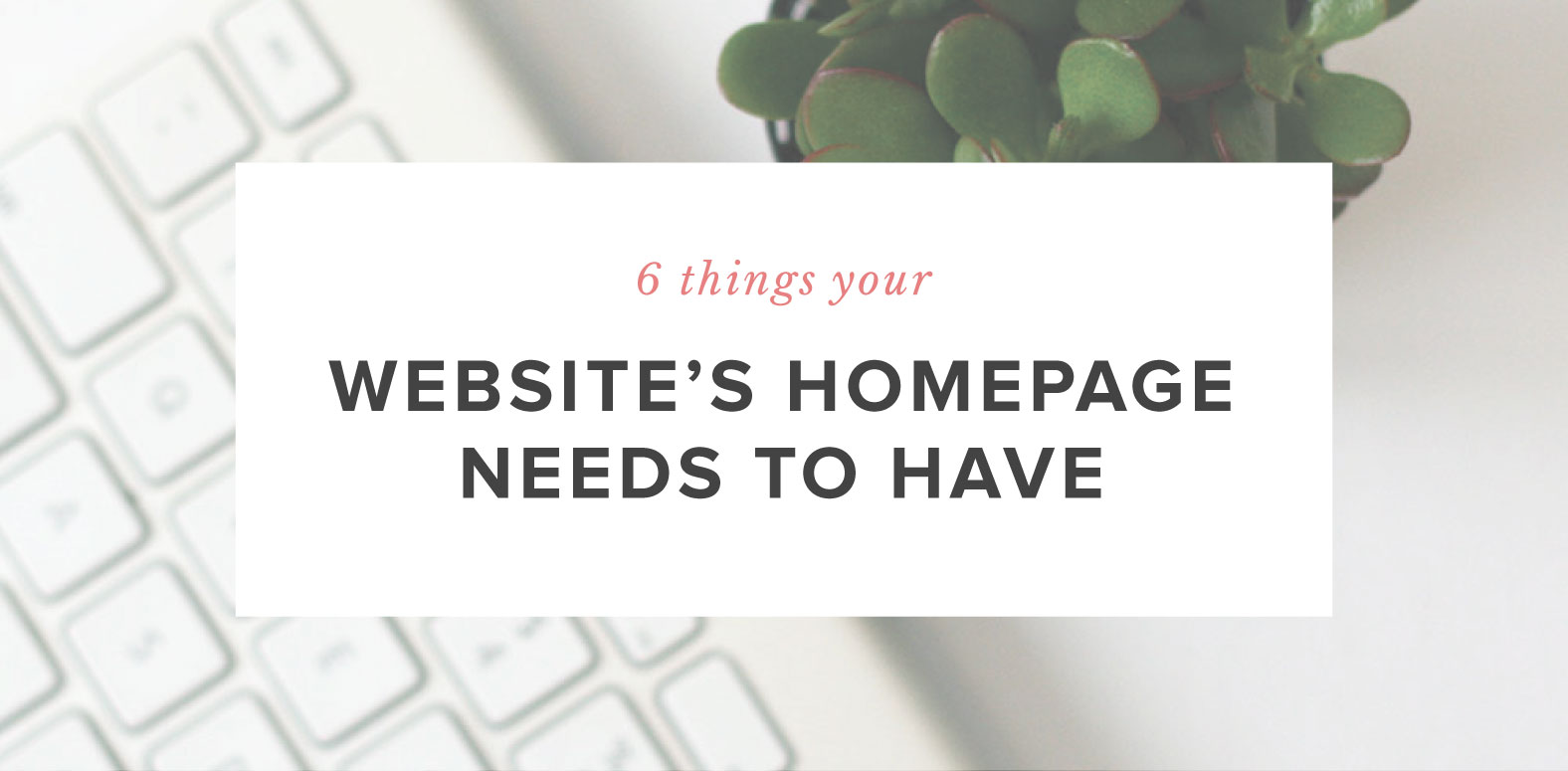Designing the perfect homepage is such a challenge if you aren’t sure what to include. Let’s take the mystery out of that, shall we?
You only have about 3 seconds to capture a viewer’s attention so your homepage should only include relevant information and shouldn’t be cluttered with excess, unnecessary, info. Let’s take a look at 6 things that every homepage should have to be successful at capturing that attention.

What You Do
Ask yourself, what is the most important thing about your business that potential clients or customers should know right away? What are the benefits of working with you? What problems do you solve for your clients?
Your homepage needs to explain your offering or service in just a quick sentence or two. It should be one of the first things that someone sees on your website, so make sure to place it above the fold – before someone needs to scroll down. Simply include what your offering and how you can help others. It should be short and, to the point, but very informative.
Never assume that anyone on your website actually knows what you do. This might be the first time that they have ever landed on your website. Having that short and sweet explanation about what you offer, lets them know immediately if they are in the right place or not.
Call to Action
Every single homepage should have at least one call to action. Think of Calls to Action, as little breadcrumbs that are sprinkled throughout your website. Each time a person sees one they will pick it up and follow it to the next crumb. This is such a powerful tool and is a great way to guide the user around your website in a strategic way.
On your homepage, you might want to take the user on a journey to learn more about you or your business – so you guide them to your services or about page. If you have an eCommerce website, you could feature a few products on the homepage that you want someone to click on when they first visit your website.
It’s completely fine to have more than one call to action on your homepage as long as they don’t compete for attention. Let’s use my homepage as an example. I have three side-by-side calls to action under the top section on the page. I placed them right next to each other because I want the user to click on the one that is best suited for them. Right under that section, I have a larger call to action to contact me to learn more about my design services. I placed this lower on the page because I want the user to get to know me before reaching out.
If you scroll down even further, you will see a final call to action for my free website workbook. These calls of action don’t compete for attention because they have a unique design, are located in various spots throughout the page and don’t include the exact same information.
Imagery & Graphics
If your website only consisted of text, it wouldn’t be very engaging and it certainly wouldn’t look very nice, now would it? Most people are visual learners and they’ll look at the graphics and imagery on your website first to get an idea of what you are all about. If they like what they see, they will read headlines and then, finally, the body copy.
This is why it’s so important to choose photos that are supportive of the copy on your website. If you’re a service-based business, this usually means including pictures of your work or of an office setting. For eCommerce, showcase lifestyle pictures of your products. If you want to personalize your homepage, even more, you should include a photo of yourself.
Make sure that your photos are on brand because they will be establishing the mood of your website. If your brand identity is very feminine then your photos should be light and bright and dark colors should be avoided. It’s also totally fine to use stock images but choose ones that really represent your business and that aren’t cheesy.
Custom icons are another great way to showcase what you do in a visual way. I use icons on my client’s homepages all the time to go over what services they offer. Icons are great because they lead the eye to read the copy bellow or next to the icon.
An illustration is another amazing way to bring an artistic feel to your brand and website. It will really set you apart from others because it’s used less often on the web.
Content Offer
Even if you’re just starting out, you should be capturing emails on your homepage. It’s a great opportunity to reach out to people who are already interested in you or what you’re offering. Social media algorithms are always changing and a platform that is working for you today might go out of style in a couple of years. Then what? If you don’t have an email list, you might be out of luck.
Now that we’ve gone over the importance of an email list, let’s talk about how to actually get people to sign-up on your homepage. I hate to break it to you, but having a soft ask like “sign-up for my newsletter” isn’t going to get a lot of traffic. I can tell you from experience because I used to have that on my website. Over the course of 6 months, I only got a few people to sign-up for my list and most of them were already clients of mine.
You’re asking people to share their email address with you and that’s kind of a private thing. If you want people to join your list, you need to offer something in return for that email address. Try creating a free offering like an eBook, a course, guide, checklist, or anything that is related to your expertise. If you make something that is helpful and exchange it for an email address you are a lot more likely to get people to sign-up for your list.
Testimonials
If you’re a service-based business and have a few testimonials from past clients, then including one or two of them on your homepage, it’s is a great way to build credibility.
Having a separate testimonials page is also great, but, if nobody clicks it, they won’t see how much you have helped your clients. That’s why it’s a good idea to include a few of your favorite testimonials on your homepage too.
If your business is brand-new and you don’t have any testimonials then think about how you can ask your future clients for feedback. Develop a simple questionnaire that you can send out to clients a month or two after your project has wrapped up. Ask specific questions about the kind of growth they’ve seen from your services and what benefited them most.
If you simply ask for a testimonial, you are putting the wording into the hands of your client and you might get something back that is nice but isn’t results oriented. For instance “working with so-and-so was so much fun!” is really nice, but it doesn’t explain how your client benefited from your services. Creating this questionnaire in advance will make it really easy for you to send out after you have worked with a few clients. At that point, you can add a couple of testimonials to your homepage.
Main Navigation & Social Icons
One of the biggest mistakes that I see on other websites is the lack of a clear and simple navigation. Your main navigation should be at the top of your website and should only include pages that provide value. If you have pages on the main nav that aren’t necessary then see if you can combine the content with another relevant page, move the page to a secondary menu (try the footer or sidebar of your website), or remove the page completely.
If at all possible, remove any sub-navigation – aka drop-down menus – from your website too. More and more people are viewing websites on mobile devices which favor fewer clicks and more scrolling. Think about it, do you want a really important page to be hidden until someone happens to hover, or worse, click on the top-level navigation to see more? I didn’t think so. Be up-front about what a page includes by naming it appropriately so that a person on your website knows where they should go to find the info they’re looking for.
Lastly, make sure that you include social media icons on your homepage. I usually like to place these in either the header or footer of any website that I design so that they are easy for people to find no matter what page they are browsing. Connecting on social media is a great way for people to get to know you more before they consider working with you in the future.
And, there you have it! 6 things that should be included on every homepage design. Take a look at your current website and see if you are missing a few of these things. If you are, try to incorporate them into your current homepage design or maybe consider a re-design of your website.
If you need a little more help, download my Wellness Website Workbook to help you create a health + wellness website that gets results. The workbook includes 4 sections that you can work through at your own pace. Once you’re done, you’ll have a clear vision so you can book out your schedule.
You only get one homepage. Let’s make it work harder. Get a free expert review of your homepage, so it actually attracts your dream clients!
Free Homepage Health Check
Copyright 2022 - All Rights Reserved | Website made by Jules Design (of course!)
Terms & Conditions
Privacy Policy
We are a Richmond Virginia based website design and brand identity design studio for dietitians, nutritionists, health coaches, fitness professionals and wellness entrepreneurs. We love working with brands with compassion in the health space.
